These are great. Laughed at reason 11 on the video- good one!
Nation- (and City-) Specific Victory City Markers
-
@CWO:
As for Shanghai and Hong Kong, Nobel Hobo suggested using the Yu Garden and the Wong Tai Sin Temple respectively. The Main Altar of the Wong Tai Sin Temple would be a good choice, in my opinion, for Hong Kong. I’d then opt for a Yu Garden building that looks distinctively different from the Hong Kong marker – so for Shanghai, I’d pick the Yu Garden’s Dianchun Hall, which is built in a different style from the Main Altar and has a stream and a nice little bridge beside it.
These are both good choices.
-
@CWO:
For Sydney, Nobel Hobo proposed using the Sydney Harbour Bridge, an idea which would be along the lines of using the Golden Gate Bridge for San Francisco. The two bridges are very different in appearance, which is good, and the Sydney one opened in 1932, so that fits with the required WWII time frame.
For Calcutta, Nobel Hobo proposed using Victoria Memorial Hall. Ossell commented that not a lot of people would recognize it; I concur with this point, and I would add that the building doesn’t look particularly Indian. (It was designed by an Englishman and its style apparently “uses a mixture of British and Mughal elements as well as Venetian, Egyptian, Deccani and Islamic architectural influences”.)  I had earlier proposed the Taj Mahal as a possibility, but I had also pointed out that it was in the wrong city. As it turns out, it has the additional problem of being an example of Islamic rather than Indian architecture. So my preference would be for the Dakshineswar Kali Temple, a Hindu temple located near Kolkata. Admittedly it doesn’t score a lot of points on the recognizability scale, but it has the virtue of being built in a traditional style of Bengal architecture.
These are fine. I wouldn’t change a thing here.
-
@CWO:
For Manila, Nobel Hobo proposed using the Jose Rizal Monument. That would be one possibility, and so would the Intramuros citadel district of Manila – more specifically, Fort Santiago. Another option might by to use Corregidor Island, which is just 30 or so miles away, has a fairly distinctive saddle shape and is, of course, famous in WWII history.
For Warsaw, Nobel Hobo proposed using the Wilanów Palace, which would be one possibility. Other options would be: 1) the Old Town Market Place with the Warsaw Mermaid statue at its centre; 2) the Warsaw Barbican; or 3) one of Warsaw’s many churches, for example the Carmelite Church, a.k.a. the Church of the Assumption of the Virgin Mary and of St. Joseph, which appears to have a small onion dome that gives it a nice Slavic architectural touch.
I don’t have an answer for Manila. That one is hard. As far as Warsaw, I like the top picture or the far right one of the Church.
-
WOW! :-o
A lot of great research here! You’ve certainly saved me a lot of work.
First of all, I’d like to say that I agree with you on not doing the generic molded roundel versions (although that may be an alternative, possibly lower cost option that I can offer later). I feel like if you’re going to spend the money on the markers, they might as well be unique.
A couple of comments:
Stalingrad - I’d like to stick to buildings if possible, for two reasons.
- Comparative scales: the other markers are buildings, so I think the smaller statues might seem out of place.
- Organic shapes (i.e. people) are much harder to model in my program than structural shapes.
What about a distinctive building like the “Univermag Department Store” building that the Germans used as an HQ during the battle (see attached)? I seem to remember something like this in “Enemy at the Gates”.
I suppose I can give the statues a stab, we’ll see.
Honolulu - I had a cool idea for this one, maybe modeling the whole southern coast of Oahu, complete with Diamond Head on one side, a little Waikiki Beach with downtown Honolulu, and the outline of Pearl Harbor on the other side. I’ll have to see if I can fit it all, but I think it would be cool.
Tokyo - I might end up doing something like D.C., with Edo Castle on one side and the Meiji Shrine on the other. Again, I’ll have to see how it looks. I like the capital markers to be a bit more stately and impressive.
Other than that, I loved all you guys’ suggestions. I’ll keep working on these next week.
Coming up…
MOSCOW!

-
Ossel,
This is such a exciting, cool idea and I love your prototypes thus far! I just have to ask, cause i’m too excited to paint these and get them into a gaming experience,……any rough idea as too when you might produce/ offer these for sale?? In the mean time I’ve been waiting forever for HBG to release their Japanese expansion, brits, axis minor, uncle sam, and French concept sets!!
-
Thanks for the feedback everyone. Here are a few additional thoughts.
Regarding Ossel’s point about comparative scales, which is a good one, this would indeed rule out the small Barmaley Fountain for Stalingrad , but not the “Worker and Kolkhoz Woman” statue (which is 78 feet high) nor “The Motherland Calls” (which, at 279 feet, is taller than the Statue of Liberty if you exclude the latter’s large pedestal).
As for the program’s limitations at handling organic shapes, this is indeed a difficulty – but here I’d say that, personally, I’d be fine with a model that suggests in broad outline (rather than in fine detail) the shape of a statue whose appearance is sufficiently distinctive. The model which Ossel has already produced of the Eiffel Tower illustrates this point: the depiction is very simple compared to the original, yet it’s perfectly recognizable. So on that count, “The Motherland Calls” would win over “Worker and Kolkhoz Woman” because its recognizability and “Sovietness” is less dependent on fine detail, relying instead on its colossal scale and its dramatic pose. The more I think about it, the more I’d be inclined to pick “The Motherland Calls” for these reasons and for the following additional one: “Worker and Kolkhoz Woman” has one wrong element (wrong city) and one right element (correct time period), while “The Motherland Calls” has one wrong element (wrong time period) and two right elements (correct city, and direct association with the Battle of Stalingrad).
However, if Ossel were for whatever reason to decide to use a building to represent Stalingrad, I agree that the Univermag Department Store would probably work better than any of the building options I can think of. (I can’t get very excited at the prospect of a marker modeled after, let’s say, the “F.E. Dzerzhinskogo Stalingrad Tractor Factory Number 3”, and Pavlov’s House was architecturally just a small and nondescript building.)
Ossel’s suggestion of using the Edo Castle (containing the Tokyo Imperial Palace) raises an interesting point: the markers which have already been designed, or whose choices seem to be attracting a consensus, can be grouped into different categories. Some focus on a single structure (such as the Eiffel Tower, the Brandenburg Gate and the Colosseum). Some show a large urban area dominated by one or two distinctive adjoining structures (such as Washington, which shows the Capitol Building and the Washington Monument). And some are projected to show an even larger landscape: San Francisco Bay and the Golden Gate Bridge (for San Francisco), Diamond Head, Waikiki Beach, Honolulu and Pearl Harbor (for Honolulu). The grounds of the Tokyo Imperial Palace (see picture below) would fall into the large-landscape category. (Incidentally, incorporating the Edo Castle on one side and the Meiji Shrine on the other side of the same model would be problematic because they’re in two different districts of Tokyo – Chiyoda and Shibuya. On that scale, the buildings would be too small to see.) The same large-landscape concept could be applied to Manila by depicting the walled Intramuros district (see picture below). And in fact the same concept could even be applied to Stalingrad, whose layout was fairly distinctive: a city built in three major sections on hilly bluffs on the west side of a bend in the river Volga.
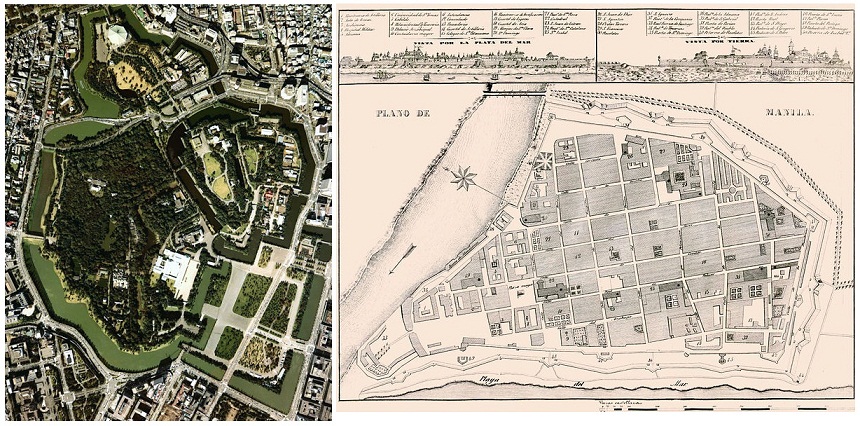
-
Mark, I agree with everyone, that you have done a incredible job researching for Ossel, for some fantastic possibilities for sculpts. Manila is the only one that has given me trouble. I can’t decide what I want for it.
-
Manila is the only one that has given me trouble. I can’t decide what I want for it.
Another possibility would be the J-shaped Cavite Navy Yard (and perhaps the surrounding Manila Bay), located just 8 miles from Manila.
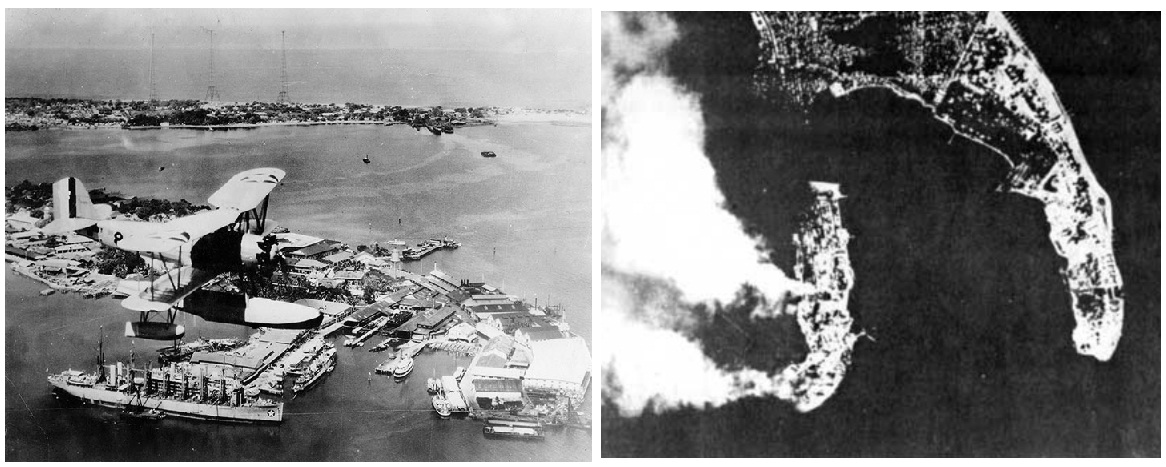
-
@CWO:
 Manila is the only one that has given me trouble. I can’t decide what I want for it.
Another possibility would be the J-shaped Cavite Navy Yard (and perhaps the surrounding Manila Bay), located just 8 miles from Manila.
I don’t know, I think your first two choices were better options.
Which one do you like the best?
-
Which one do you like the best?
I’m having a tough time with this one myself. Singapore was sometimes called “the Gibraltar of the East” but Manila is shaping up as “the Stalingrad of the East” because both cities have multiple marker options but no obvious front-runner.
-
I don’t know if this is relevant, but we use two different colored flags for capital city control in Global games, and for victory cities we use Fortress America 1e cities in two different colors (Axis/Red) (Allies/Blue). Here’s a pic of them. The cap;ital flags are in UK, France, Berlin, and Italy. You can see non-capital victory cities in Poland and Novgorod.
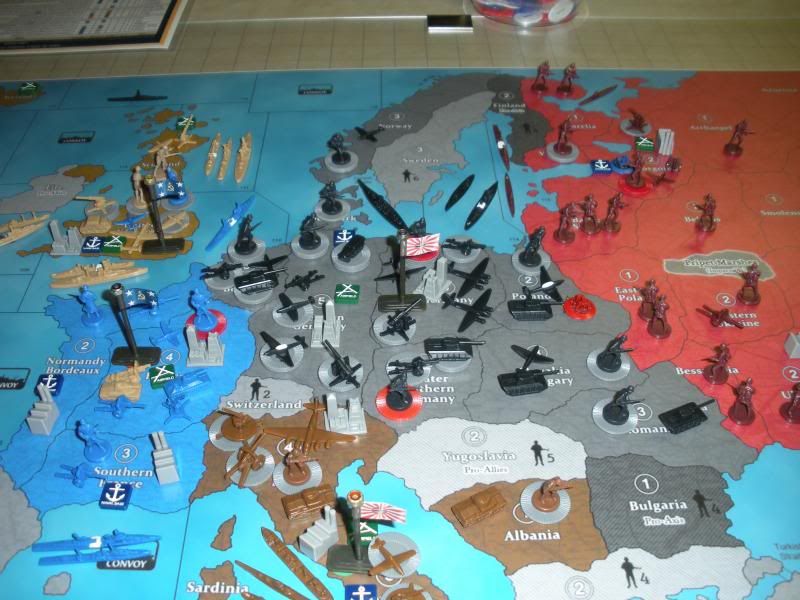
Simple yes, but easy to identify when checking victory city control.
-
……any rough idea as too when you might produce/ offer these for sale??
Thanks for your interest!
So here’s my production plan right now. Obviously I have to finish the design work first, and I’m currently cranking out a single design in 1-2 days. I’m uploading to Shapeways as I go to check for manufacturablity, and right now everything looks good. I also want to order my own set to check the quality and so I can provide pictures of the printed product on the sales pages. So, I would think a conservative estimate is that they would be ready to sell in about a month or so.
I want to see if I can sell complete sets as well (to possibly save cost and for added convenience), perhaps a Global set and a smaller set for different editions (perhaps a 1914 set eventually?), but I have to see if this is possible through the site.
Again, thanks to everyone for the interest and feedback! It is very much appreciated!
-
MOSCOW MONDAY!
Next is Tokyo Tuesday!
-
MOSCOW MONDAY!
Beautiful!
Next is Tokyo Tuesday! <<
To be followed by Warsaw Wednesday? (Just kidding…)
Keep up the great work!
-
@CWO:
MOSCOW MONDAY!
Beautiful!
Next is Tokyo Tuesday! <<
To be followed by Warsaw Wednesday? (Just kidding…)
I thought about that, but it sort of breaks down after Wednesday lol! I’m out of “T”'s and I don’t work on these on the weekend!
In all seriousness, I’ll probably do Honolulu after Tokyo. I’m anxious to try out my Oahu coast concept.
-
I don’t know if this is relevant, but we use two different colored flags for capital city control in Global games
I like your concept of having joint-nation flags (US/USSR and Japan/Germany), which are potentially usable in various ways, so for the fun of it I’ve just made a couple of them using a different design, based on the five major powers of the classic A&A games. One is a US/UK/USSR flag and one is a Germany/Japan flag. I’ve posted them below:
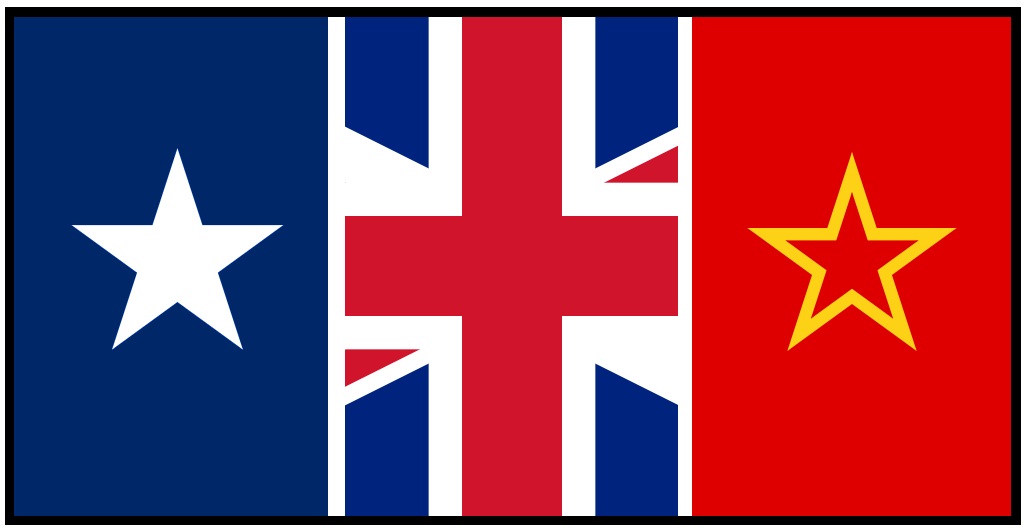
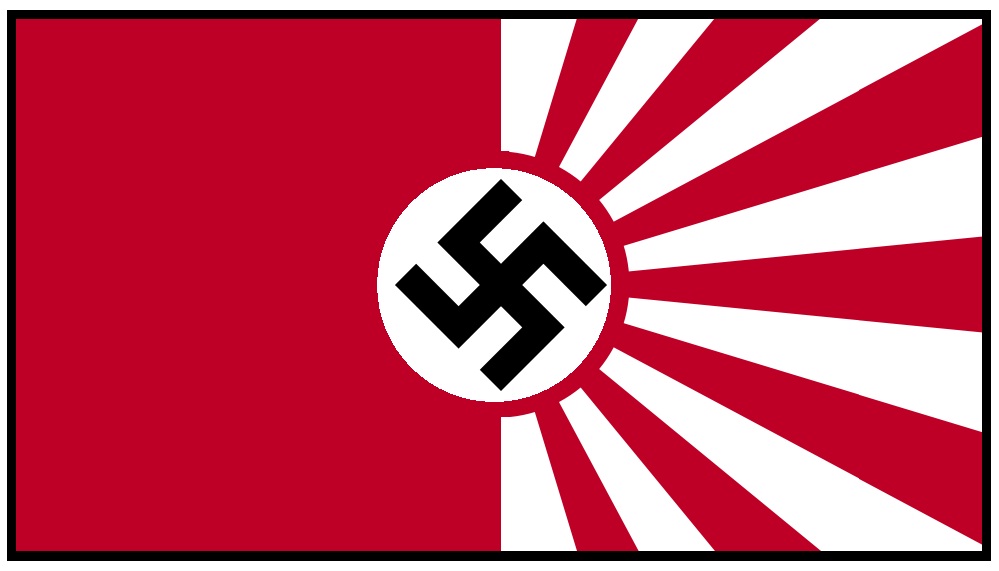
-
-
Wow, the German flag mixed with the Japanese flag, looks cool! :-D
-
Wow, the German flag mixed with the Japanese flag, looks cool! :-D
P-Unit provided the basis of the concept by putting the A&A German roundel in the middle of the Japanese flag, which I thought was a clever use of the fact that both historical flags had central discs. The book “Reluctant Allies: German-Japanese Naval Relations in World War II”, however, shows that cooperation between the Germans and the Japanese during WWII was marginal at best; for all practical purposes, they fought independent wars. The US/UK/USSR alliance did a little better in terms of cooperation, but in general terms the US ran its own show in the Pacific, the USSR ran its own show on the Eastern Front, and the UK was close to being a one-man operation in India, Burma and the Indian Ocean. It was only in North Africa, southern and western Europe, and the Atlantic that the British and the Americans conducted full-blown joint operations on a large scale. So while these joint Allied and Axis flag designs are fun for gaming purposes, all the parties concerned would have been horrified at the concept in real life.
-
@CWO:
Wow, the German flag mixed with the Japanese flag, looks cool! :-D
P-Unit provided the basis of the concept by putting the A&A German roundel in the middle of the Japanese flag, which I thought was a clever use of the fact that both historical flags had central discs. The book “Reluctant Allies: German-Japanese Naval Relations in World War II”, however, shows that cooperation between the Germans and the Japanese during WWII was marginal at best; for all practical purposes, they fought independent wars. The US/UK/USSR alliance did a little better in terms of cooperation, but in general terms the US ran its own show in the Pacific, the USSR ran its own show on the Eastern Front, and the UK was close to being a one-man operation in India, Burma and the Indian Ocean. It was only in North Africa, southern and western Europe, and the Atlantic that the British and the Americans conducted full-blown joint operations on a large scale. So while these joint Allied and Axis flag designs are fun for gaming purposes, all the parties concerned would have been horrified at the concept in real life.
Yes, so true about the war. I just like the matching colors of both flags together. They mesh well together is what I meant.







